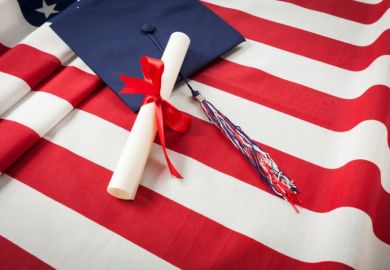Take Exit 272 off the Interstate 80 highway in Nebraska and you will soon be in the city of Kearney in the Platte River Valley. Renowned as the best place in the world to see migratory sandhill cranes, Kearney (population 30,000) is also home to an arm of the state university system.
With 5,200 undergraduates and 1,600 graduate students, the University of Nebraska Kearney (UNK) constitutes a significant part of the city’s population and is an important element in the city and regional economy, which is dominated by light manufacturing and agriculture. The UNK started as a two-year school in 1903, evolved into a teachers’ college, then a state college, and became part of the University of Nebraska system in 1991.
Most of its students are from Nebraska and pay about $5,400 (£4,000) in tuition and spend about $11,000 annually on fees, accommodation and living expenses. The out-of-state students are charged $12,000 for tuition. But more than 60 per cent of Kearney’s full-time undergraduates get some financial aid.
What attracted my attention was that the UNK’s endowment of $65,712 was the smallest endowment of the 1,400 or so US and Canadian colleges and universities responding to the latest survey of finances by NACUBO, the National Association of College and University Business Officers. This is about $10 for each current student. The total is roughly equal to one year’s tuition, room and board at a liberal arts college such as Sarah Lawrence.
By comparison, 95 institutions reported endowments of more than $1 billion. This was not just the usual suspects of Harvard ($36 billion), Yale ($25 billion), Stanford and Princeton (both about $22 billion) but large state universities such as the universities of Tulsa, Utah, and Georgia (all just over $1 billion) and a couple of relatively small undergraduate institutions such as Berea College in Kentucky ($1.1 billion) and Swarthmore College ($1.8 billion).
The 95 billion-dollar-plus institutions, and another 25 colleges and universities, hold about 75 per cent of the combined market value of US college and university endowments. It is an intense concentration of wealth and an indicator of how much is invested in these elite, and for the most part, research-oriented institutions.
Although the UNK is not a trust fund baby, it has a lot going for it. It offers a wide range of undergraduate programmes, many of them oriented towards the needs of the region. It has more than 150 student organisations, which range from fraternities and sororities to community service groups. The UNK is not as diverse as the nation as a whole – only about 10 per cent of the student population is either Hispanic or African American. However, neither is the state of Nebraska: 89 per cent of the population is white, far greater than the US average (66 per cent).
Like many universities, the UNK has more female (59 per cent) than male students. However, it serves many young people who are the first in their family to go to college – 40 per cent of all undergraduates. The UNK is almost an open access institution, offering admission to more than 80 per cent of all applicants. Its students are also relatively successful, with about 55 per cent of each incoming class of about 1,000 graduating in six years or less, which is about the norm for public universities and considerably better than the average of 32 per cent for open admission institutions.
Employment rates on graduation are high, particularly for the more professionally oriented programmes such as accounting, information technology, and science and mathematics teacher preparation. Many of the graduates from its education programme work in schools across Nebraska. The graduate programmes are dominated by master’s that are largely tied to the state’s requirements for employment and advancement in Nebraska’s public schools.
This is the less-heralded face of US higher education. Regional comprehensive universities such as the UNK educate 4 million students annually, 20 per cent of all undergraduates, the majority of whom are minority, non-traditional, low-income and first-generation students. The emphasis in the UNK’s vision statement is fostering a good learning environment, offering opportunities for community engagement and public service, and producing graduates who “lead responsible and productive lives in a democratic, multicultural society”.
Leon Botstein, Bard College’s long-standing and iconoclastic president, once described elite institutions as “banks where the front door is education”. The UNK shows that even without a strategy of hoarding resources for a rainy day, high-quality higher education can be provided for the daughters and sons of Middle America.
Alan Ruby is a senior scholar at the Alliance for Higher Education and Democracy in the University of Pennsylvania’s Graduate School of Education.
Write for us
If you are interested in blogging for us, please email chris.parr@tesglobal.com
POSTSCRIPT:
Print headline: World insight: the untold story of US higher education is one of unassuming local heroes
Register to continue
Why register?
- Registration is free and only takes a moment
- Once registered, you can read 3 articles a month
- Sign up for our newsletter
Subscribe
Or subscribe for unlimited access to:
- Unlimited access to news, views, insights & reviews
- Digital editions
- Digital access to THE’s university and college rankings analysis
Already registered or a current subscriber?







